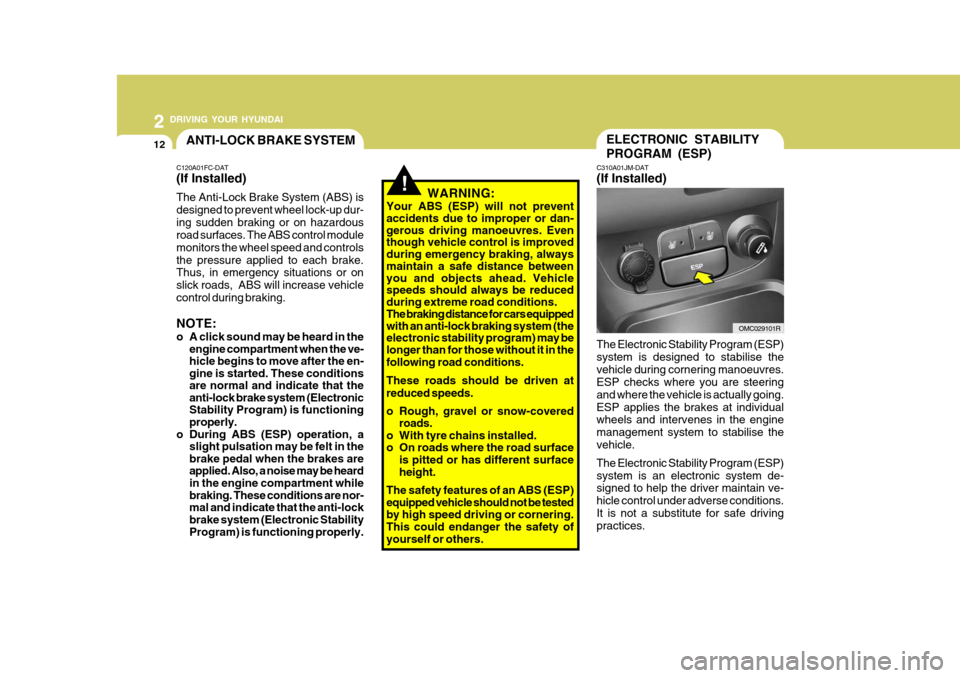snow chains Hyundai Accent 2009 Owner's Manual - RHD (UK. Australia)
[x] Cancel search | Manufacturer: HYUNDAI, Model Year: 2009, Model line: Accent, Model: Hyundai Accent 2009Pages: 232, PDF Size: 8.36 MB
Page 139 of 232

2 DRIVING YOUR HYUNDAI
12ANTI-LOCK BRAKE SYSTEMELECTRONIC STABILITY PROGRAM (ESP)
C310A01JM-DAT (If Installed)
OMC029101R
The Electronic Stability Program (ESP) system is designed to stabilise thevehicle during cornering manoeuvres. ESP checks where you are steering and where the vehicle is actually going.ESP applies the brakes at individual wheels and intervenes in the engine management system to stabilise thevehicle. The Electronic Stability Program (ESP) system is an electronic system de- signed to help the driver maintain ve- hicle control under adverse conditions.It is not a substitute for safe driving practices.
!WARNING:
Your ABS (ESP) will not prevent accidents due to improper or dan- gerous driving manoeuvres. Even though vehicle control is improved during emergency braking, always maintain a safe distance between you and objects ahead. Vehicle speeds should always be reduced during extreme road conditions. The braking distance for cars equipped
with an anti-lock braking system (the
electronic stability program) may be
longer than for those without it in the following road conditions. These roads should be driven at reduced speeds.
o Rough, gravel or snow-covered
roads.
o With tyre chains installed.
o On roads where the road surface is pitted or has different surface height.
The safety features of an ABS (ESP) equipped vehicle should not be testedby high speed driving or cornering.This could endanger the safety of yourself or others.
C120A01FC-DAT(If Installed) The Anti-Lock Brake System (ABS) is designed to prevent wheel lock-up dur-ing sudden braking or on hazardous road surfaces. The ABS control module monitors the wheel speed and controlsthe pressure applied to each brake. Thus, in emergency situations or on slick roads, ABS will increase vehiclecontrol during braking. NOTE:
o A click sound may be heard in the
engine compartment when the ve- hicle begins to move after the en-gine is started. These conditionsare normal and indicate that theanti-lock brake system (ElectronicStability Program) is functioning properly.
o During ABS (ESP) operation, a slight pulsation may be felt in the brake pedal when the brakes areapplied. Also, a noise may be heardin the engine compartment while braking. These conditions are nor- mal and indicate that the anti-lockbrake system (Electronic Stability Program) is functioning properly.
Page 142 of 232

2
DRIVING YOUR HYUNDAI
15
2
DRIVING YOUR HYUNDAI
15
CAUTION:
1. The rear parking assist warning may not sound sequentially de- pending on the speed and shapesof the objects detected.
2. The rear parking assist system
may malfunction if the vehiclebumper height or sensor installa- tion has been modified or dam- aged. Any non-factory installedequipment or accessories may also interfere with the sensor per- formance.
3. The sensor may not recognise objects less than 15 in. (40 cm)from the sensor, or it may sensean incorrect distance. Use cau- tion.
4. When the sensor is frozen or stained with snow, dirt, or water,the sensor may be inoperative until the stains are removed using asoft cloth.
5. Do not push, scratch or strike the
sensor. Sensor damage couldoccur.
!
4. Objects generating excessive noise
(vehicle horns, loud motorcycle en- gines, or truck air brakes) are within range of the sensor.
5. Heavy rain or water spray exists.
6. Wireless transmitters or mobile phones are within range of the sen-sor.
7. The sensor is covered with snow. 8. Trailer towing The detecting range may decrease when: 1. The sensor is stained with foreign matter such as snow or water. (The sensing range will return to normal when removed.)
2. Outside air temperature is extremely hot or cold.
The following objects may not be recognised by the sensor: 1. Sharp or slim objects such as ropes, chains or small poles.
2. Objects which tend to absorb the
sensor frequency such as clothes,spongy material or snow.
3. Undetectable objects smaller than 1
m (40 in.) and narrower than 14 cm (6in.) in diameter. CAUTION:
This system can only sense objects within the range and location of the sensors; It can not detect objects inother areas where sensors are not installed. Also, small or slim ob- jects, such as poles or objects lo-cated between sensors may not be detected by the sensors. Always visually check behind thevehicle when backing up. Be sure to inform any drivers of the vehicle that may be unfamiliar withthe system regarding the systems capabilities and limitations. Your new vehicle warranty does notcover any accidents or damage to the vehicle or its occupants due to a rear parking assist system malfunc-tion. Always drive safely and cau- tiously.!
Page 146 of 232

2
DRIVING YOUR HYUNDAI
19
2
DRIVING YOUR HYUNDAI
19
C160C01A-AAT Use High Quality Ethylene Gly- col Coolant Your Hyundai is delivered with high quality ethylene glycol coolant in the cooling system. It is the only type ofcoolant that should be used because it helps prevent corrosion in the cooling system, lubricates the water pump andprevents freezing. Be sure to replace or replenish your coolant in accor- dance with the maintenance schedulein Section 5. Before winter, have your coolant tested to assure that its freez- ing point is sufficient for the tempera-tures anticipated during the winter.
It should be noted that installing tyrechains on the tyre will provide a greaterdriving force, but will not prevent side skids. NOTE: Tyre chains are not legal in all states. Check state laws before fitting tyrechains.WINTER DRIVING
C160B01A-DAT Snowy or Icy Conditions To drive your vehicle in deep snow, it may be necessary to use snow tyres or to install tyre chains on your tyres. If snow tyre are needed, it is necessaryto select tyres equivalent in size and type to the original equipment tyres. Failure to do so may adversely affectthe safety and handling of your car. Furthermore, speeding, rapid accel- eration, sudden brake applications, andsharp turns are potentially very haz- ardous practices. During deceleration, use engine brak-ing to the fullest extent. Sudden brake applications on snowy or icy roads may cause skids to occur. You need to
keep sufficient distance between the vehicle in operation in front and your vehicle. Also, apply the brake gently.
C160A01A-DAT The more severe weather conditions of winter result in greater wear and other problems. To minimise the prob- lems of winter driving, you should fol-low these suggestions:
C160F02A-AAT Check Spark Plugs and Ignition System Inspect your spark plugs and replace them if necessary. Also check allignition wiring and components to be sure they are not cracked, worn or damaged in any way.
C160E01A-AAT Change to "Winter Weight" Oil if Necessary In some climates it is recommended that a lower viscosity "winter weight" oil be used during cold weather. See Section 9 for recommendations. If youaren't sure what weight oil you should use, consult your Hyundai dealer.
C160D01A-DAT Check Battery and Cables Winter puts additional burdens on the battery and charging system. Visuallyinspect the battery and cables as de- scribed in Section 6. The level of charge in your battery can be checked by yourHyundai dealer or a service station.
Page 147 of 232

2 DRIVING YOUR HYUNDAI
20
C160K01A-DAT Carry Emergency Equipment Depending on the severity of the weather where you drive your car, you should carry appropriate emergency equipment. Some of the items youmay want to carry include tyre chains, tow straps or chains, flashlight, emer- gency flares, sand, a shovel, jumpercables, a window scraper, gloves, ground cloth, overalls, a blanket, etc.
C160J01A-AAT Don't Let Ice and Snow Accumu- late Underneath Under some conditions, snow and ice can build up under the fenders andinterfere with the steering. When driv- ing in severe winter conditions where this may happen, you should periodi-cally check underneath the car to be sure the movement of the front wheels and the steering components are notobstructed.
C160G01A-DAT To Keep Locks from Freezing To keep the locks from freezing, squirt an approved de-icer fluid or glycerineinto the key opening. If a lock is cov- ered with ice, squirt it with an approved de-icing fluid to remove the ice. If thelock is frozen internally, you may be able to thaw it out by using a heated key. Handle the heated key with careto avoid injury. NOTE: The proper temperature for using the immobiliser key is from -40°C to 80°C. If you heat the immobiliser key over 80°C to open a frozen lock, itmay cause damage to the transpon- der in its head. C160H01A-DAT Use Approved Anti-Freeze in Window Washer System To keep the water in the window washer system from freezing, add an approvedanti-freeze solution in accordance with instructions on the container. Window washer anti-freeze is available fromHyundai dealers and most auto parts outlets. Do not use engine coolant or other types of anti-freeze as thesemay damage the paint finish. C160I01A-DAT Don't Let Your Hand Brake Freeze Under some conditions your hand brake can freeze in the engaged posi- tion. This is most likely to happen when there is an accumulation of snow or icearound or near the rear brakes or if the brakes are wet. If there is a risk the hand brake may freeze, apply it onlytemporarily while you put the gear selector lever in "P" (automatic) or in first or reverse gear (manual transaxle)and block the rear wheels so the car cannot roll. Then release the hand brake.
Page 217 of 232

Vehicle Identification Number (VIN) .............................. 8-2
Engine Number ............................................................. 8-3
Vehicle Compliance Plate ............................................. 8-3
Recommended Inflation Pressures .............................. 8-3
Snow Tyres .................................................................. 8-4
Tyre Chains .................................................................. 8-5
Tyre Rotation ................................................................ 8-5
Tyre Balancing .............................................................. 8-6
Tyre Traction ................................................................ 8-6
When to Replace Tyres ................................................ 8-6
Spare Tyre and Tools ................................................... 8-7
8
CONSUMER INFORMATION
8
Page 221 of 232

8
CONSUMER INFORMATION
5
!
I060A01HP
I060A02A-DAT TYRE ROTATION
Tyres should be rotated every 10,000 km (6,000 miles). If you notice that tyres are wearing unevenly betweenrotations, have the car checked by a Hyundai dealer so the cause may be corrected.After rotating, adjust the tyre pres- sures and be sure to check wheel nut torque. WARNING:
Do not mix bias-ply and radial-plyunder any circumstances. This may cause dangerous handling charac- teristics.
Spare tyre!
I050A01MC-DAT TYRE CHAINS Tyre chains, if necessary should be installed on the front wheels. Be surethat the chains are installed in accor- dance with the manufacturer's instruc- tions.To minimise tyre and chain wear, do not continue to use tyre chains when they are no longer needed.
WARNING:
o If your vehicle is equipped with 205/45R16 size tyres, do not in- stall tyre chains. This may causedamage to the vehicle (wheels,suspension and body) by chainscontacting the body.
o When driving on roads covered with snow or ice, drive at less than30 km/h (20 mph).
o Use the SAE "S" class or wire & plastic chains. o If you have noise caused by chains
contacting the body, retighten thechain to avoid contact with thevehicle body.
o To prevent body damage, retighten the chains after driving 0.5~1 km.
o Don't use tyre chains on a vehicle equipped with aluminium wheels.If it is unavoidable, use wire typechains.
o Use wire chains less than 15 mm to prevent damage to the chain'sconnection.
Page 232 of 232

10
INDEX
5
T Tachometer ................................................................ 1-56
Tail Gate .................................................................... 1-82
Theft-Alarm system ..................................................... 1-8
Towing
A trailer (or vehicle) ................................................ 2-21
Emergency ............................................................. 3-11
If your vehicle must be towed .................................. 3-9
Trailer or Vehicl e towing ............................................ 2-21
Transaxle Automatic ................................................................. 2-8
Automatic transaxle fluid checking ......................... 6-11
Manual ...................................................................... 2-6
Manual transaxle oil checking ................................ 6-11
Trip Computer ............................................................ 1-58
Trip Odometer ............................................................ 1-57
Tyre
Balancing .................................................................. 8-6
Chains ...................................................................... 8-5
Information ................................................................ 8-3
Pressure ................................................................... 8-3
Replacement ............................................................. 8-6
Rotation .................................................................... 8-5
Snow tyres ............................................................... 8-4
Spare tyre ................................................................. 3-5Traction ..................................................................... 8-6
Wheel and tyre changing .......................................... 3-6
VVehicle Identifi cation Number ...................................... 8-2 WWarning and Indicator
Lights ..................................... 1-50
Washer Reservoir ...................................................... 6-10
Window Glass ............................................................ 1-11
Power windows ....................................................... 1-12
Windshield Wiper and Washer ...................................1-63
Adjustable intermittent wiper operation ...................1-65
Rear window wiper and washer ...............................1-65
Windshield Wiper Blades ............................................. 6-9
Winter Driving ............................................................ 2-19